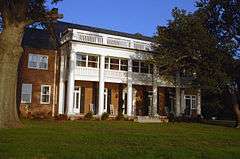Holly Knoll
|
Robert R. Moton House | |
 | |
  | |
| Location | 6496 Allmondsville Rd., near Capahosic, Virginia |
|---|---|
| Coordinates | 37°23′16.11″N 76°38′37.89″W / 37.3878083°N 76.6438583°WCoordinates: 37°23′16.11″N 76°38′37.89″W / 37.3878083°N 76.6438583°W |
| Area | 1 acre (0.40 ha)[1] |
| Built | 1935 |
| Architectural style | Colonial Revival, Other |
| NRHP Reference # | 81000640 |
| VLR # | 036-0134 |
| Significant dates | |
| Added to NRHP | December 21, 1981[2] |
| Designated NHL | December 21, 1981[3] |
| Designated VLR | March 16, 1982[4] |
Holly Knoll, also known as the Robert R. Moton House, is a historic house at 6496 Allmondsville Road in rural Gloucester County, Virginia, near Capahosic. It was the retirement home of the influential African-American educator Robert Russa Moton (1867-1940), and is the only known home of his to survive. It now houses the Gloucester Institute, a non-profit training center for African-American community leaders and educators. It was declared a National Historic Landmark in 1981.[1][3]
Description and history
Holly Knoll is located on the northeast bank of the York River, between the communities of Capahosic and Allmondsville. The main house is a 2-1/2 story brick building with a side gable roof, which is flanked by single-bay single-story wings. A two-story porch and portico extends across much of the facade, supported by smooth Tuscan columns. The interior is organized in a typical Colonial Revival central hall plan, and includes several pieces of furniture that originally belonged to Moton. The property also includes a reproduction of the log home in which Moton grew up.[1]
The house was built in 1935 for Robert Russa Moton, and was his home until his death in 1940. Moton was one of the most influential African-American educators of his generation, succeeding Booker T. Washington in the leadership of Hampton University and the Tuskegee Institute, and helping found the National Urban League.[1] The property was then transformed into a conference center, now The Gloucester Institute, dedicate to continuing Moton's educational legacy. It was at the center of strategy discussions amongst African-American intellectuals and activists during the Civil Rights movement of the 1950s and 1960s.
See also
- List of National Historic Landmarks in Virginia
- National Register of Historic Places listings in Gloucester County, Virginia
References
- 1 2 3 4 Cecil McKithan (May 23, 1981). "National Register of Historic Places Inventory-Nomination: Holly Knoll-R. R. Moton House" (pdf). National Park Service. and Accompanying photos, exterior and interior, from 19. (32 KB)
- ↑ National Park Service (2007-01-23). "National Register Information System". National Register of Historic Places. National Park Service.
- 1 2 "Robert R. Moton House". National Historic Landmark summary listing. National Park Service. Retrieved 2008-04-15.
- ↑ "Virginia Landmarks Register". Virginia Department of Historic Resources. Retrieved 5 June 2013.

